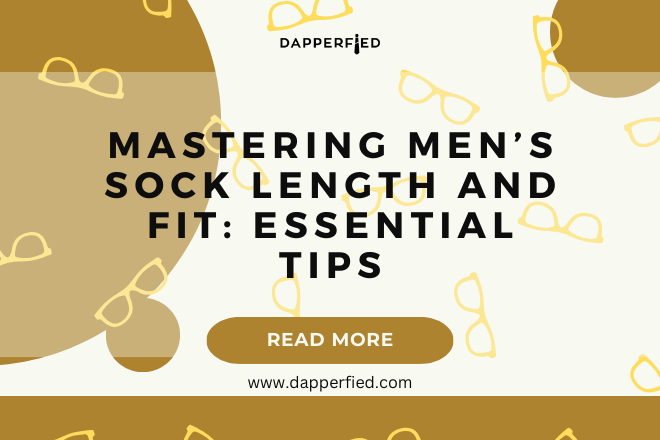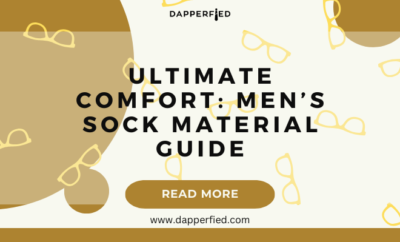
Men's Style
Choosing the Perfect Sock for Men
Selecting appropriate socks is a crucial decision that significantly affects comfort and foot health. Socks serve as more than just a fashion accessory; they protect feet from friction, moisture, and odor. Wearing unsuitable socks can result in blisters, discomfort, and potential foot health issues.
For athletes, professionals, and individuals seeking daily comfort, choosing the right socks is essential. Well-chosen socks provide cushioning, support, and moisture-wicking properties to maintain dry and comfortable feet. Conversely, ill-suited socks may cause irritation, overheating, and contribute to foot conditions like athlete’s foot or toenail fungus.
Therefore, investing time in selecting appropriate socks is crucial for foot health and overall comfort. When choosing socks, it is important to consider factors such as material, fit, and intended use. Different activities and environments require specific sock types, making it essential to select socks that meet particular needs.
Options are available for everyday wear, athletic activities, and formal occasions, catering to various preferences. Understanding the different types of men’s socks and the factors to consider when selecting them ensures the best choice for foot comfort and overall well-being.
Key Takeaways
- Choosing the right sock is important for comfort, support, and overall foot health.
- Different types of socks for men include dress socks, athletic socks, and casual socks.
- Factors to consider when choosing socks include material, fit, purpose, and personal style.
- Sock materials like cotton, wool, and synthetic blends offer various benefits such as breathability, moisture-wicking, and durability.
- Sock length and style options range from no-show and ankle socks to crew and knee-high socks, with various patterns and colors to suit different occasions and preferences.
- Tips for finding the perfect fit include knowing your shoe size, considering the sock’s elasticity, and trying on different brands and styles.
- Maintenance and care for men’s socks involve washing them in cold water, avoiding bleach and fabric softeners, and air-drying or tumble-drying on low heat.
Different Types of Socks for Men
Athletic Socks for Active Men
Athletic socks are designed to provide cushioning, support, and moisture-wicking properties to keep your feet comfortable during physical activity. These socks are often made from synthetic materials such as polyester or nylon, which help to wick away moisture and prevent blisters.
Dress Socks for Formal Occasions
Dress socks, on the other hand, are typically made from more luxurious materials such as cotton, wool, or silk, and are designed to complement formal attire. These socks often come in a variety of colors and patterns to suit different styles and occasions.
Casual and Specialty Socks for Everyday Wear
For everyday wear, casual socks are a popular choice for their versatility and comfort. These socks are often made from cotton or a cotton blend and come in a wide range of colors and patterns to suit different preferences. Compression socks are another type of sock that has gained popularity in recent years for their ability to improve circulation and reduce swelling in the legs and feet. These socks are often recommended for athletes, travelers, or individuals who spend long periods of time on their feet. Additionally, there are also specialty socks designed for specific activities such as hiking, skiing, or hunting. These socks are often made from durable materials and feature additional padding and support in specific areas to provide comfort and protection during these activities.
Factors to Consider When Choosing Socks
When choosing socks for men, there are several important factors to consider to ensure that you’re making the best choice for your needs. One of the most important factors to consider is the material of the sock. Different materials offer different benefits in terms of comfort, moisture-wicking properties, and durability.
For example, cotton is a popular choice for its softness and breathability, while wool is known for its warmth and moisture-wicking properties. Synthetic materials such as polyester and nylon are often used in athletic socks for their ability to wick away moisture and prevent blisters. It’s important to consider the material of the sock based on your specific needs and preferences.
Another important factor to consider is the fit of the sock. A well-fitting sock should be snug but not too tight, with no extra fabric that could cause bunching or discomfort. The right fit will ensure that the sock stays in place and provides the necessary support and cushioning for your feet.
Additionally, it’s important to consider the purpose of the sock when making your selection. Whether you need socks for athletic activities, formal occasions, or everyday wear, there are specific types of socks designed to meet these needs. By considering these factors when choosing socks, you can ensure that you’re making the best choice for your comfort and overall foot health.
Sock Materials and Their Benefits
| Sock Material | Benefits |
|---|---|
| Cotton | Soft, breathable, and absorbs moisture |
| Wool | Insulating, moisture-wicking, and odor-resistant |
| Polyester | Durable, quick-drying, and retains shape |
| Nylon | Strong, stretchy, and resistant to abrasion |
| Spandex | Elastic, form-fitting, and enhances flexibility |
Socks are made from a variety of materials, each with its own unique benefits in terms of comfort, moisture-wicking properties, and durability. Cotton is one of the most popular materials for socks due to its softness and breathability. Cotton socks are comfortable to wear and allow air to circulate around the feet, helping to keep them dry and cool.
However, cotton does have a tendency to absorb moisture, so it may not be the best choice for athletic activities where moisture-wicking properties are important. Wool is another popular material for socks, particularly in colder climates. Wool socks are known for their warmth and moisture-wicking properties, making them an excellent choice for outdoor activities in cold weather.

Wool is also naturally odor-resistant, making it a great choice for individuals who are prone to foot odor. Additionally, wool is a durable material that can withstand frequent washing and wear. Synthetic materials such as polyester and nylon are often used in athletic socks for their ability to wick away moisture and prevent blisters.
These materials are lightweight, durable, and quick-drying, making them an excellent choice for high-intensity activities. They also provide excellent support and cushioning for the feet during physical activity. When choosing socks, it’s important to consider the material based on your specific needs and preferences.
Whether you’re looking for comfort, moisture-wicking properties, warmth, or durability, there are a variety of materials available to suit your needs.
Sock Length and Style Options
Socks come in a variety of lengths and styles to suit different preferences and occasions. Ankle socks are a popular choice for athletic activities or casual wear during warmer months. These socks provide coverage for the foot without extending past the ankle, making them a versatile option for various types of footwear.
Crew socks are a classic choice for everyday wear and provide coverage that extends past the ankle to mid-calf. They are a popular choice for casual wear with sneakers or boots and come in a variety of colors and patterns to suit different styles. Dress socks are typically longer in length, extending over the calf to complement formal attire such as suits or dress shoes.
These socks often come in a variety of colors and patterns to suit different styles and occasions. In addition to length, there are also various style options available for men’s socks. From solid colors to bold patterns and designs, there are endless options to suit different preferences and occasions.
Whether you prefer classic styles or more modern designs, there is a wide range of options available to complement your wardrobe.
Tips for Finding the Perfect Fit
Size Matters
When it comes to size, it’s essential to choose socks that are appropriate for your shoe size. Socks that are too small can cause discomfort and restrict circulation, while socks that are too large can cause bunching and irritation. Many sock brands offer sizing options based on shoe size to help you find the perfect fit.
Purpose-Driven Socks
The purpose of the sock is another crucial factor to consider when choosing the right fit. For athletic activities, choose socks that provide support and cushioning in specific areas such as the heel and arch. For formal occasions, opt for dress socks that provide coverage over the calf and complement formal attire.

Personal Preferences
Lastly, consider your personal preferences when choosing the perfect fit. Whether you prefer snug-fitting ankle socks or longer crew socks with extra cushioning, there are various options available to suit your preferences.
Maintenance and Care for Men’s Socks
Proper maintenance and care are essential for prolonging the life of your socks and ensuring that they continue to provide comfort and support. To keep your socks in good condition, it’s important to follow care instructions provided by the manufacturer. This may include washing them in cold water with mild detergent, avoiding bleach or fabric softeners, and air-drying them instead of using a dryer.
It’s also important to inspect your socks regularly for signs of wear and tear such as holes or thinning fabric. If you notice any damage, it’s important to repair or replace your socks as needed to prevent discomfort or irritation. Additionally, it’s important to rotate your socks regularly to prevent excessive wear on specific pairs.
By rotating your socks, you can ensure that they maintain their shape and support over time. By following these maintenance tips and caring for your socks properly, you can prolong their lifespan and continue to enjoy their comfort and support for years to come.
If you’re looking for the perfect pair of socks to go with your new Converse Chuck Taylor sneakers, you might want to check out this article on Understanding Big Men’s Watches for the Well-Fed Gent. It offers great tips on finding the right accessories to complement your style, including the importance of choosing the right socks for your footwear.
FAQs
What are the different types of socks for men?
There are various types of socks for men, including dress socks, athletic socks, casual socks, and compression socks. Each type serves a different purpose and is designed for specific activities or occasions.
What should men consider when choosing socks?
When choosing socks, men should consider the material, thickness, length, and purpose of the socks. The material should be breathable and moisture-wicking, the thickness should be appropriate for the intended activity, the length should be suitable for the footwear, and the purpose should match the intended use of the socks.
What are the best materials for men’s socks?
The best materials for men’s socks are typically natural fibers such as cotton, wool, and bamboo, as they are breathable, moisture-wicking, and comfortable. Synthetic materials like polyester and nylon can also be used for athletic socks due to their moisture-wicking properties.
How should men choose the right sock length?
Men should choose the right sock length based on the type of footwear they will be wearing. For dress shoes, shorter socks that sit below the calf are typically preferred, while for boots or athletic shoes, longer socks that cover the calf are more suitable.
What are some common sock mistakes men should avoid?
Common sock mistakes men should avoid include wearing socks that are too thin or too thick for the footwear, wearing socks that are too short or too long for the shoes, and wearing socks with visible holes or wear. It’s also important to match the color and style of the socks to the outfit and occasion.

















